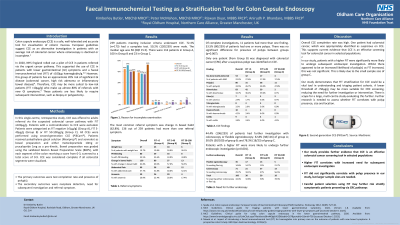Monday Poster Session
Category: Colon
P1579 - Fecal Immmunochemical Testing as a Stratification Tool for Colon Capsule Endoscopy
Monday, October 23, 2023
10:30 AM - 4:15 PM PT
Location: Exhibit Hall

Has Audio
- KB
Kimberley A. Butler, MBChB
Northern Care Alliance
Oldham, England, United Kingdom
Presenting Author(s)
Kimberley A. Butler, MBChB, Peter McMahon, MBChB, Rizwan Diyar, MBBS, Anirudh P. Bhandare, MBBS
Northern Care Alliance, Oldham, England, United Kingdom
Introduction: Colon capsule endoscopy (CCE) is a safe and accurate tool for visualisation of colonic mucosa. In patients with an average risk of colorectal cancer where colonoscopy is declined or incomplete, European guidelines suggest CCE as an alternative investigation. Recent UK guidance on triaging patients with lower gastrointestinal symptoms supports the use of CCE in patients with a faecal immunochemical test (FIT) of 10-100µg/g. This aims to identify those less likely to require subsequent intervention, such as biopsy or polypectomy.
Methods: In this single-centre, retrospective study, CCE was offered to adults referred via the suspected colorectal cancer pathway with FIT ≤100µg/g. Patients were categorised as FIT negative (< 5µg/g) (group A), FIT 5-49µg/g (group B) or FIT 50-100µg/g (group C). The primary outcomes were test completion rate and presence of polyp(s). The secondary outcomes were neoplasia detection, subsequent investigation and referral symptom.
Results: 239 patients meeting inclusion criteria underwent CCE. 72.4% (n=173) had a complete test. 50.2% (120/239) were male. The median age was 58 (IQR 15.5). 33.5% (n=80) had one or more polyps. The most common referral symptom was change in bowel habit (62.7% [n=150]). In group A, 27.6% (32/116) had a normal CCE and 26.7% (31/116) had polyp(s). In group B, 17.0% (17/100) had a normal CCE and 38.0% (38/100) had polyps. In group C, 17.4% (4/23) had a normal CCE and 47.8% (11/23) had polyp(s). 44.4% (106/239) of patients had further investigation with colonoscopy or flexible sigmoidoscopy: 32.8% (38/116) of group A; 50.0% (50/100) of group B; and 78.3% (18/23) of group C. Only one patient was diagnosed with colorectal cancer. Patients with a FIT 50-100µg/g were more likely to undergo further invasive investigation (p< 0.001), but there was no significant difference for presence of polyps between groups (p=0.067).
Discussion: CCE completion rate was high. One patient had colorectal cancer, which was appropriately identified as suspicious on CCE, supporting current evidence that CCE is an effective screening tool in selected populations. In our study, patients with a higher FIT (50-100µg/g) were more likely to undergo subsequent investigation. There was no significant difference in polyp presence between the groups, likely due to the small size of group C. FIT stratification for CCE could be a vital tool in further understanding patient cohorts. Further research is needed to assess whether FIT correlates with polyp presence and size.
Disclosures:
Kimberley A. Butler, MBChB, Peter McMahon, MBChB, Rizwan Diyar, MBBS, Anirudh P. Bhandare, MBBS. P1579 - Fecal Immmunochemical Testing as a Stratification Tool for Colon Capsule Endoscopy, ACG 2023 Annual Scientific Meeting Abstracts. Vancouver, BC, Canada: American College of Gastroenterology.
Northern Care Alliance, Oldham, England, United Kingdom
Introduction: Colon capsule endoscopy (CCE) is a safe and accurate tool for visualisation of colonic mucosa. In patients with an average risk of colorectal cancer where colonoscopy is declined or incomplete, European guidelines suggest CCE as an alternative investigation. Recent UK guidance on triaging patients with lower gastrointestinal symptoms supports the use of CCE in patients with a faecal immunochemical test (FIT) of 10-100µg/g. This aims to identify those less likely to require subsequent intervention, such as biopsy or polypectomy.
Methods: In this single-centre, retrospective study, CCE was offered to adults referred via the suspected colorectal cancer pathway with FIT ≤100µg/g. Patients were categorised as FIT negative (< 5µg/g) (group A), FIT 5-49µg/g (group B) or FIT 50-100µg/g (group C). The primary outcomes were test completion rate and presence of polyp(s). The secondary outcomes were neoplasia detection, subsequent investigation and referral symptom.
Results: 239 patients meeting inclusion criteria underwent CCE. 72.4% (n=173) had a complete test. 50.2% (120/239) were male. The median age was 58 (IQR 15.5). 33.5% (n=80) had one or more polyps. The most common referral symptom was change in bowel habit (62.7% [n=150]). In group A, 27.6% (32/116) had a normal CCE and 26.7% (31/116) had polyp(s). In group B, 17.0% (17/100) had a normal CCE and 38.0% (38/100) had polyps. In group C, 17.4% (4/23) had a normal CCE and 47.8% (11/23) had polyp(s). 44.4% (106/239) of patients had further investigation with colonoscopy or flexible sigmoidoscopy: 32.8% (38/116) of group A; 50.0% (50/100) of group B; and 78.3% (18/23) of group C. Only one patient was diagnosed with colorectal cancer. Patients with a FIT 50-100µg/g were more likely to undergo further invasive investigation (p< 0.001), but there was no significant difference for presence of polyps between groups (p=0.067).
Discussion: CCE completion rate was high. One patient had colorectal cancer, which was appropriately identified as suspicious on CCE, supporting current evidence that CCE is an effective screening tool in selected populations. In our study, patients with a higher FIT (50-100µg/g) were more likely to undergo subsequent investigation. There was no significant difference in polyp presence between the groups, likely due to the small size of group C. FIT stratification for CCE could be a vital tool in further understanding patient cohorts. Further research is needed to assess whether FIT correlates with polyp presence and size.
Disclosures:
Kimberley Butler indicated no relevant financial relationships.
Peter McMahon indicated no relevant financial relationships.
Rizwan Diyar indicated no relevant financial relationships.
Anirudh Bhandare indicated no relevant financial relationships.
Kimberley A. Butler, MBChB, Peter McMahon, MBChB, Rizwan Diyar, MBBS, Anirudh P. Bhandare, MBBS. P1579 - Fecal Immmunochemical Testing as a Stratification Tool for Colon Capsule Endoscopy, ACG 2023 Annual Scientific Meeting Abstracts. Vancouver, BC, Canada: American College of Gastroenterology.

